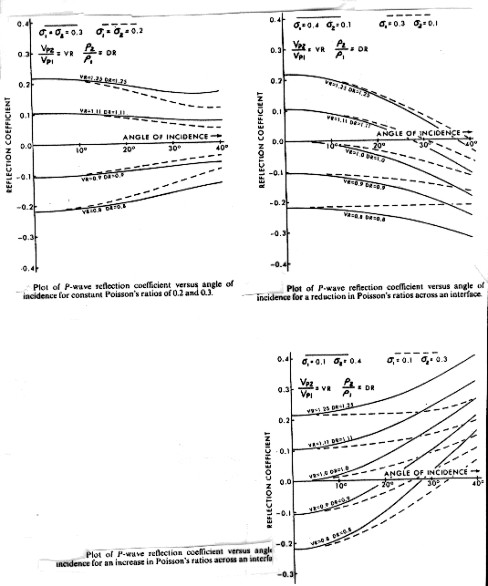|
 Amplitude Versus Offset (AVO)
Amplitude Versus Offset (AVO)
A technique used to differentiate seismic reflection events caused
by lithology changes from those caused by fluid changes is called
amplitude versus offset, or AVO, processing. The effect is caused
by the fact that the reflected energy depends not only on the
acoustic impedance but also on the angle of incidence of the reflecting
energy.
The
contribution of this second effect is often ascribed to the difference
between Poisson's ratio of the layers. However, the equations
clearly show the cause to be the difference in compressional velocities:
For vertical or non-vertical incidence:
_____1: K = (Vavg - Vo)
/ DEPTH
_____2: ANGLE = Arctan
((DEPTH * X + Vo * X/K)/(DEPTH^2 + 2*Vo*DEPTH / K - X^2 /
4))
_____3: Vrat = Vc2 / Vc1
__OR 3a: Vrat = DTC1 / DTC2
_____4: Drat = DENS2 / DENS1
_____5: C = (Vrat^2 + (1
- Vrat^2) / (Cos(ANGLE))^2) ^ 0.5
_____6: Refl = (1 - Vrat
* Drat * C) / (1 + Vrat * Drat * C)
C
= 1 for vertical incidence.
Poisson's
ratio has the same contrast as compressional velocity when a liquid
is replaced by a gas saturation. This is true because Poisson's
ratio is a function of compressional to shear velocity ratio,
and shear velocity doesn't change much with changes in fluid content.
The
net result is the same, no matter how it is described. For constant
Poisson's ratio above and below a boundary, amplitude decreases
with offset. If the upper
layer has a higher Poisson's ratio than the lower, positive peaks
decrease in amplitude and could go negative, while negative peaks
get larger. The reverse takes place when Poisson's ratio contrast
is reversed.

Amplitude versus offset schematic
There
are other causes of amplitude versus offset variations:
1. source directivity and array effects
2. receiver arrays
3. near surface velocity variations
4. geometrical spreading
5. propagation loss of high frequencies (earth filtering)
6. dispersive phase distortion
7. velocity anisotropy
8. waveform interference (thin beds)
9. short period multiple interference
10. reflector curvature
11. processing effects (moveout stretch, time variant scaling,
etc.)
Some
adequate accounting or control must be given for each of these
effects in order to relate the remaining amplitude variation to
reflectivity changes. Model studies are an essential element in
deciding if these other effects have been properly corrected.
Synthetic seismograms made this way will show the effects of amplitude
versus offset. The conventional synthetic seismogram might tie
the near trace data, but should not be expected to always agree
well with the stacked data or the far trace data.
|

